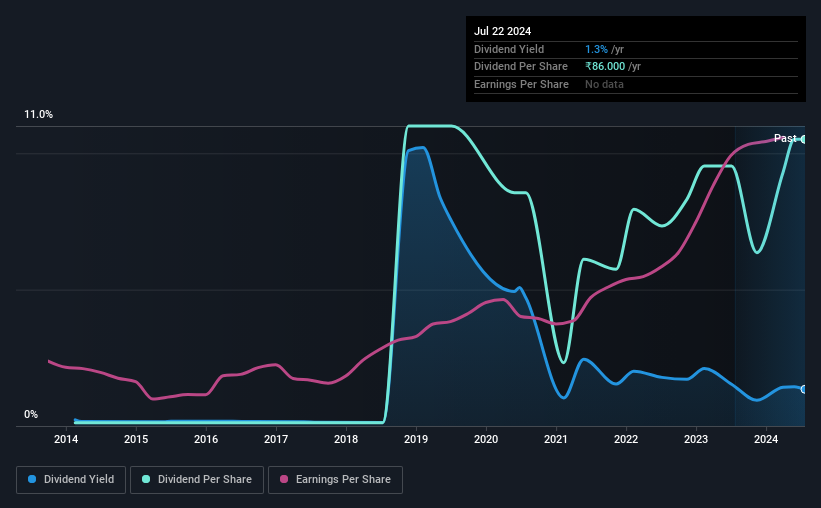ESAB India's (NSE:ESABINDIA) Shareholders Will Receive A Bigger Dividend Than Last Year

ESAB India Limited (NSE:ESABINDIA) will increase its dividend from last year's comparable payment on the 7th of September to ₹30.00. This makes the dividend yield 1.3%, which is above the industry average.
See our latest analysis for ESAB India
ESAB India's Dividend Is Well Covered By Earnings
If the payments aren't sustainable, a high yield for a few years won't matter that much. Prior to this announcement, ESAB India's dividend was making up a very large proportion of earnings and perhaps more concerning was that it was 118% of cash flows. Paying out such a high proportion of cash flows can expose the business to needing to cut the dividend if the business runs into some challenges.
Earnings per share could rise by 23.1% over the next year if things go the same way as they have for the last few years. If the dividend continues along recent trends, we estimate the payout ratio could reach 79%, which is on the higher side, but certainly still feasible.

Dividend Volatility
The company's dividend history has been marked by instability, with at least one cut in the last 10 years. The dividend has gone from an annual total of ₹1.00 in 2014 to the most recent total annual payment of ₹86.00. This means that it has been growing its distributions at 56% per annum over that time. Dividends have grown rapidly over this time, but with cuts in the past we are not certain that this stock will be a reliable source of income in the future.
ESAB India's Dividend Might Lack Growth
Growing earnings per share could be a mitigating factor when considering the past fluctuations in the dividend. ESAB India has impressed us by growing EPS at 23% per year over the past five years. Fast growing earnings are great, but this can rarely be sustained without some reinvestment into the business, which ESAB India hasn't been doing.
The Dividend Could Prove To Be Unreliable
Overall, we always like to see the dividend being raised, but we don't think ESAB India will make a great income stock. In general, the distributions are a little bit higher than we would like, but we can't ignore the fact the quickly growing earnings gives this stock great potential in the future. This company is not in the top tier of income providing stocks.
Companies possessing a stable dividend policy will likely enjoy greater investor interest than those suffering from a more inconsistent approach. Still, investors need to consider a host of other factors, apart from dividend payments, when analysing a company. To that end, ESAB India has 2 warning signs (and 1 which can't be ignored) we think you should know about. Looking for more high-yielding dividend ideas? Try our collection of strong dividend payers.
Valuation is complex, but we're here to simplify it.
Discover if ESAB India might be undervalued or overvalued with our detailed analysis, featuring fair value estimates, potential risks, dividends, insider trades, and its financial condition.
Access Free AnalysisHave feedback on this article? Concerned about the content? Get in touch with us directly. Alternatively, email editorial-team (at) simplywallst.com.
This article by Simply Wall St is general in nature. We provide commentary based on historical data and analyst forecasts only using an unbiased methodology and our articles are not intended to be financial advice. It does not constitute a recommendation to buy or sell any stock, and does not take account of your objectives, or your financial situation. We aim to bring you long-term focused analysis driven by fundamental data. Note that our analysis may not factor in the latest price-sensitive company announcements or qualitative material. Simply Wall St has no position in any stocks mentioned.
Have feedback on this article? Concerned about the content? Get in touch with us directly. Alternatively, email editorial-team@simplywallst.com
About NSEI:ESABINDIA
ESAB India
Manufactures and sells welding and cutting equipment and consumables in India.
Flawless balance sheet average dividend payer.


